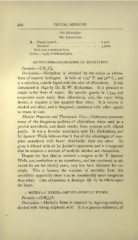Page 462 - My FlipBook
P. 462
460 DENTAL MEDICINE.
For Odotitalgia.
Dr. Schaeffer.
R . Phenol crystals I part
Mentboli 3 parts.
Melt over a moderate heat.
SiGNA.—Apply to inflamed pulp.
METHYLENE—BICHLORIDE OF METHYLENE.
Formula.—C Hg. Clj.
Derivation.—Methylene is obtained by the action on chloro-
form of nascent hydrogen. It boils at 104° F. and 40° C, and
is a colorless, volatile liquid with the odor of chloroform. It was
introduced in 1840 by Dr. B. W. Richardson. It is pleasant to
inhale in the form of vapor. Its specific gravity is 1.344, and
evaporates more easily than chloroform, and, the vapor being
denser, it requires a less quantity than ether. It is soluble in
alcohol and ether, and is frequently combined with other agents
to lessen its cost.
Medical Properties and Therapeutic Uses.—Methylene possesses
many of the dangerous qualities of chloroform when used as a
general anaesthetic, and death results from syncope with dilated
pupils. It was a favorite anaesthetic with Dr. Richardson, and
Sir Spencer Wells believes that it has all the advantages of com-
plete anaesthesia with fewer drawbacks than any other. He
gives it diluted with air by Junker's apparatus, and it is supposed
that he employs a mixture of methylic alcohol and chloroform.
Despite the fact that so eminent a surgeon as Sir T. Spencer
Wells uses methylene as an anaesthetic, and has continued to ad-
vocate its use for twenty years, very few have followed his ex-
ample. This is because the statistics of mortality from this
anaesthetic apparently show it to be considerably more dangerous
than ether. Like chloroform it destroys life by its effects upon
the heart.
METHYLIC ETHER—METHYL-ETHYLIC ETHER.
Formula.—(C 113)20.
Derivation.—Methylic Ether is obtained by digesting methylic
alcohol with strong sulphuric acid. It is a gaseous substance, of


